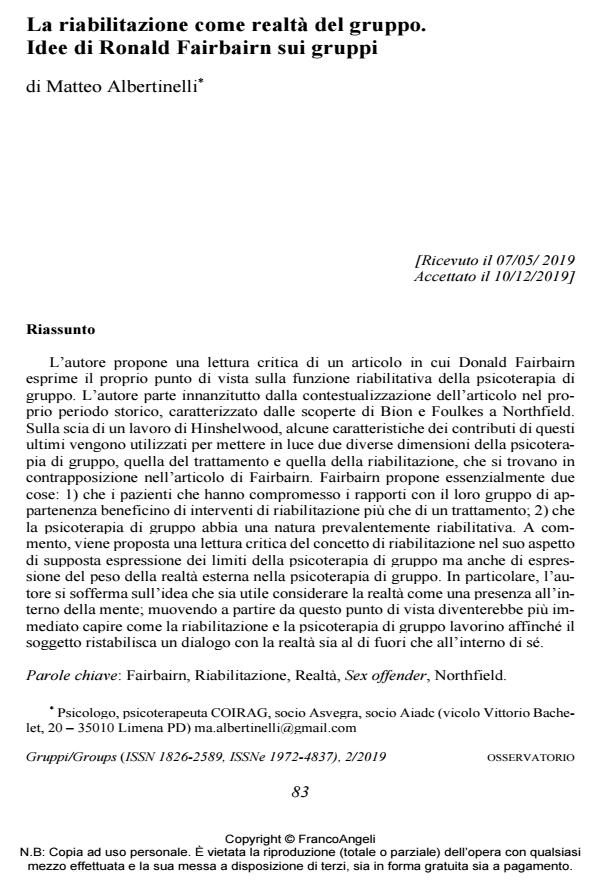La riabilitazione come realtà del gruppo. Idee di Ronald Fairbairn sui gruppi
Titolo Rivista GRUPPI
Autori/Curatori Matteo Albertinelli
Anno di pubblicazione 2020 Fascicolo 2019/2
Lingua Italiano Numero pagine 13 P. 83-95 Dimensione file 158 KB
DOI 10.3280/GRU2019-002007
Il DOI è il codice a barre della proprietà intellettuale: per saperne di più
clicca qui
Qui sotto puoi vedere in anteprima la prima pagina di questo articolo.
Se questo articolo ti interessa, lo puoi acquistare (e scaricare in formato pdf) seguendo le facili indicazioni per acquistare il download credit. Acquista Download Credits per scaricare questo Articolo in formato PDF

FrancoAngeli è membro della Publishers International Linking Association, Inc (PILA)associazione indipendente e non profit per facilitare (attraverso i servizi tecnologici implementati da CrossRef.org) l’accesso degli studiosi ai contenuti digitali nelle pubblicazioni professionali e scientifiche
L’autore propone una lettura critica di un articolo in cui Donald Fairbairn esprime il proprio punto di vista sulla funzione riabilitativa della psicoterapia di gruppo. L’autore parte innanzitutto dalla contestualizzazione dell’articolo nel pro-prio periodo storico, caratterizzato dalle scoperte di Bion e Foulkes a Northfield. Sulla scia di un lavoro di Hinshelwood, alcune caratteristiche dei contributi di que-sti ultimi vengono utilizzati per mettere in luce due diverse dimensioni della psico-terapia di gruppo, quella del trattamento e quella della riabilitazione, che si trova-no in contrapposizione nell’articolo di Fairbairn. Fairbairn propone essenzialmente due cose: 1) che i pazienti che hanno compromesso i rapporti con il loro gruppo di appartenenza beneficino di interventi di riabilitazione più che di un trattamento; 2) che la psicoterapia di gruppo abbia una natura prevalentemente riabilitativa. A commento, viene proposta una lettura critica del concetto di riabilitazione nel suo aspetto di supposta espressione dei limiti della psicoterapia di gruppo ma anche di espressione del peso della realtà esterna nella psicoterapia di gruppo. In particola-re, l’autore si sofferma sull’idea che sia utile considerare la realtà come una pre-senza all’interno della mente; muovendo a partire da questo punto di vista diven-terebbe più immediato capire come la riabilitazione e la psicoterapia di gruppo la-vorino affinché il soggetto ristabilisca un dialogo con la realtà sia al di fuori che all’interno di sé.
Parole chiave:Fairbairn, Riabilitazione, Realtà, Sex offender, Northfield.
- Il ritiro sociale è un'esperienza che ci riguarda tutti? Riflessioni sull'hikikomori a partire da un film contemporaneo Matteo Albertinelli, in GRUPPI 1/2024 pp.203
DOI: 10.3280/gruoa1-2022oa17973
Matteo Albertinelli, La riabilitazione come realtà del gruppo. Idee di Ronald Fairbairn sui gruppi in "GRUPPI" 2/2019, pp 83-95, DOI: 10.3280/GRU2019-002007